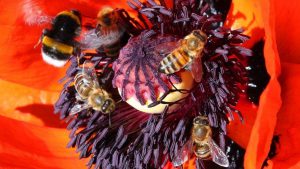What does it mean for plants and bees if spring comes early?

Honey bees and ground bumblebees fly with thick purple pollen pouches to the flower of a corn poppy, also called poppy or corn rose, to obtain nectar in Berlin, Germany, Tuesday, June 7, 2022. (Wolfgang Kumm/dpa via AP)
As several Canadians in some parts of the country deal with an abundance of snow and severe winter storms, most are likely looking ahead to brighter, warmer days in the spring.
And while spring may not arrive as quickly as some hope this year, according to the Weather Network, that can be a blessing or a curse for certain aspects of the environment, according to two separate studies.
The arrival of an early spring can be good for plants, North Carolina State University researchers say, while it’s bad for bees according to research from Lund University.
BAD NEWS FOR BEES
A new study from Sweden’s Lund University, meanwhile, shows bumblebee queens are ending their hibernation earlier in the year because of climate change.
Queens are the only bees that survive throughout winter by hibernating, after which they fly to find a nest where they can lay eggs and start a colony.
According to the study, the rising temperatures caused by climate change that could lead to an earlier spring are what’s driving bees to wake up earlier—an average of five days earlier than 20 years ago.
Researcher Maria Blasi Romero says the phenomenon increases the risk of losing additional bumblebee species, and having less pollination of crops and wild plants.
“Across Sweden, we see that the increased temperatures due to climate change clearly affect when the queens wake up and fly to find a new nest,” said Romero.
However, warmer weather earlier in the year is not the only reason for changes in bee behaviour. The study notes the loss of meadows and pastures in Sweden over the past century as another major factor.
Scientists looked at bumblebee queens as far back as 117 years ago, finding the first bumblebee flights in intensively farmed areas now happen roughly two weeks earlier than more than 100 years ago.
Additionally, of the 10 bee species that researchers looked at, the ones that used to start flying earliest in spring now start even earlier, while other species haven’t changed when they end hibernation.
Researcher Anna S Persson says there is a risk this can lead to bumblebees not getting enough food and a mismatch between when flowering plants and bees are active.
“We see a clear risk that more bumblebee species are at risk of extinction locally, especially the species that usually emerge later in the summer. This could also lead to a decline in the number of bumblebees overall and that would have consequences for the pollination of crops and the functioning of ecosystems. Bumblebees are important pollinators, especially in northern latitudes such as in Scandinavia,” Persson said.
Lund University researchers add there are several ways to help reduce the effects of climate change on pollinators such as bumblebees, including preserving natural grasslands, mowing roadsides later in the season after the flowering period, designing flower strips and hedges in a way that favors pollinators and increasing the sowing of clover-rich leys that are partly allowed to flower.
AN EARLY SPRING CAN BE GOOD FOR PLANTS
If spring comes earlier in the year, researchers from North Carolina State University say it can affect the amount of leaves plants produce, and therefore increase the amount of carbon plants can capture and store during photosynthesis.
In the study published in Global Biogeochemical Cycles, authors note the amount of leaves plants are able to produce is what’s known as “greening,” while a decrease in vegetation growth is called “browning.”
Researchers used satellites to measure plant “greening” between 2000 and 2014 as well as sensors to calculate how much carbon plants removed from the atmosphere each year during photosynthesis.
Study co-author Josh Gray, associate professor of forestry and environmental resources at North Carolina State University, says climate change is the biggest reason for differences in “greening” and “browning” every year.
“As we work to anticipate the future climate, a big question is: What’s going to happen to vegetation, one of the largest stores of carbon on earth?” Gray said. “We know temperatures will rise and the growing season will be longer in most places, but there are a lot of unknowns about how that will affect how carbon is cycled between plants and the atmosphere. Our new results allow us to be more confident about what those changes will be.”
In addition to when seasons start and how long they last, Gray says warmer weather can meddle with photosynthesis and contribute to new plant growth in some parts of the world.
Xiaojie Gao, a graduate student in North Carolina State’s Center for Geospatial Analytics and the study’s first author, says an earlier spring may be good for plants because they have a longer time to photosynthesize and increase how much carbon they can capture.
“However, a longer autumn might make the situation worse. In autumn, plants tend to emit carbon,” Gao said.
The study concludes “greening” trends matter more to “carbon uptake”—how much carbon plants can capture—than changes in the length of seasons.
“There are some places where we have more leaves than we used to have, particularly at the higher latitudes,” Gray said. “There are also some places where spring might be coming early, and fall might be coming late. These changes are all affecting the amount of photosynthesis that is going on, but the amount of leaves plants are producing has a stronger association with carbon uptake than changes in growing season length.”
We are here to share current happenings in the bee industry. Bee Culture gathers and shares articles published by outside sources. For more information about this specific article, please visit the original publish source: Early spring good for plants, bad for bees: studies | CTV News








